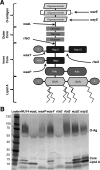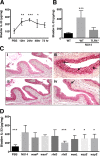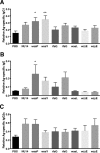Lipopolysaccharide Domains Modulate Urovirulence
- PMID: 27528276
- PMCID: PMC5067746
- DOI: 10.1128/IAI.00315-16
Lipopolysaccharide Domains Modulate Urovirulence
Abstract
Uropathogenic Escherichia coli (UPEC) accounts for 80 to 90% of urinary tract infections (UTI), and the increasing rate of antibiotic resistance among UPEC isolates reinforces the need for vaccines to prevent UTIs and recurrent infections. Previous studies have shown that UPEC isolate NU14 suppresses proinflammatory NF-κB-dependent cytokines (D. J. Klumpp, A. C. Weiser, S. Sengupta, S. G. Forrestal, R. A. Batler, and A. J. Schaeffer, Infect Immun 69:6689-6695, 2001, http://dx.doi.org/10.1128/IAI.69.11.6689-6695.2001; B. K. Billips, A. J. Schaeffer, and D. J. Klumpp, Infect Immun 76:3891-3900, 2008, http://dx.doi.org/10.1128/IAI.00069-08). However, modification of lipopolysaccharide (LPS) structure by deleting the O-antigen ligase gene (waaL) enhanced proinflammatory cytokine secretion. Vaccination with the ΔwaaL mutant diminished NU14 reservoirs and protected against subsequent infections. Therefore, we hypothesized that LPS structural determinants shape immune responses. We evaluated the contribution of LPS domains to urovirulence corresponding to the inner core (waaP, waaY, and rfaQ), outer core (rfaG), and O-antigen (waaL, wzzE, and wzyE). Deletion of waaP, waaY, and rfaG attenuated adherence to urothelial cells in vitro In a murine UTI model, the ΔrfaG mutant had the most severe defect in colonization. The mutation of rfaG, waaL, wzzE, and wzyE resulted in an inability to form reservoirs in mouse bladders. Infection with the LPS mutant panel resulted in various levels of urinary myeloperoxidase. Since the ΔwaaL mutant promoted Th1-associated adaptive responses in previous studies (B. K. Billips, R. E. Yaggie, J. P. Cashy, A. J. Schaeffer, and D. J. Klumpp, J Infect Dis 200:263-272, 2009, http://dx.doi.org/10.1086/599839), we assessed NU14 for Th2-associated cytokines. We found NU14 infection stimulated TLR4-dependent bladder interleukin-33 (IL-33) production. Inoculation with rfaG, waaL, wzzE, and wzyE mutants showed decreased IL-33 production. We quantified antigen-specific antibodies after infection and found significantly increased IgE and IgG1 in ΔwaaP mutant-infected mice. Our studies show LPS structural constituents mediate multiple aspects of the UPEC life cycle, including the ability to acutely colonize bladders, form reservoirs, and evoke innate and adaptive immune responses.
Copyright © 2016, American Society for Microbiology. All Rights Reserved.
Figures







References
-
- Burt CW, Schappert SM. 2004. Ambulatory care visits to physician offices, hospital outpatient departments, and emergency departments: United States, 1999-2000. Vital Health Stat 13:1–70. - PubMed
-
- Ejrnaes K. 2011. Bacterial characteristics of importance for recurrent urinary tract infections caused by Escherichia coli. Dan Med Bull 58:B4187. - PubMed
MeSH terms
Substances
Grants and funding
LinkOut - more resources
Full Text Sources
Other Literature Sources
Medical
Research Materials

